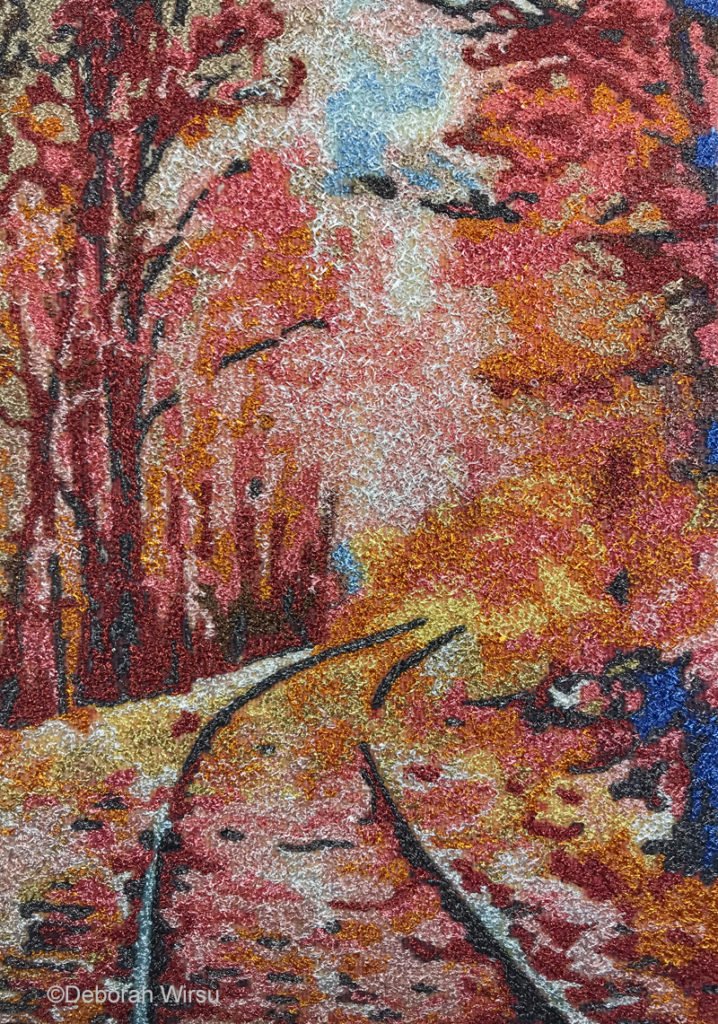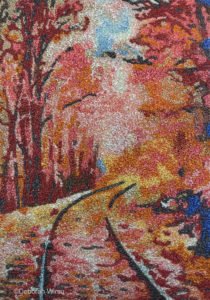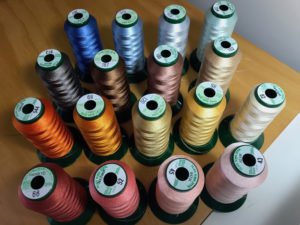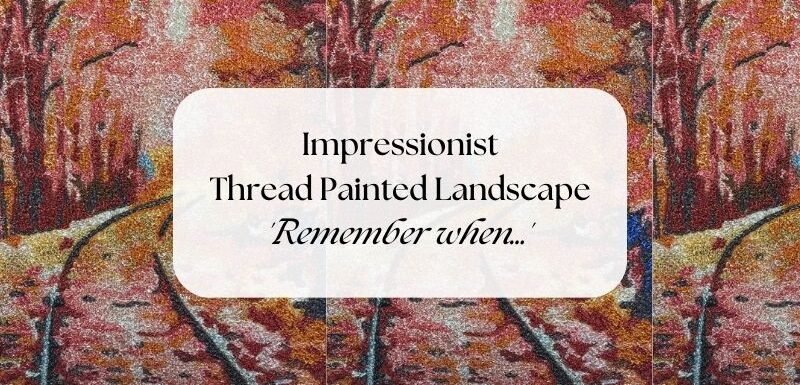Well, last week I tried to break out to a different style (Fibre Art: Thread Sketch with Fabric Paint), but I knew it wouldn’t take me long to return to doing an Impressionist thread painted landscape! So I created #16 in the Journey Through Landscape series: Remember when…

Affiliate Disclosure: Some of the links on this site are affiliate links. This means I may receive a small commission (at no further expense to you) if you click through and make a purchase. ThreadSketchingInAction.com is a participant in the Amazon Services LLC Associates Program, an affiliate advertising program designed to provide a means for sites to earn commission fees by advertising and linking to Amazon.com.
‘Remember when…’ – continuing my Impressionist thread painted Journey Through Landscape
I’ve had the original photo for this project sitting around for a while (a long while, actually). I kept coming across it, finding it strangely alluring, but something was holding me back from getting started turning with it into a thread painting.
Sensing a touch of déjà vu relating to Journey Through Landscape #15, which I also struggled to get underway, I realised that I mustn’t let these doubts stop me.
Finally, it dawned on me what the stumbling block was: I was finding this one hard. I was a little fearful of beginning because I didn’t want to get started, only to find I’d done a lot of work for nothing.
I just didn’t know where to start with it; couldn’t figure out what approach to take; couldn’t face the inevitable hundreds of stops and starts while I changed the thread (lol) in the machine. (Usually, that doesn’t bother me at all!)
Faced with two choices – give up or push through it – I decided to take the latter path. It’s not in my nature to give up, and this idea had been lingering for long enough!
The challenges …
Challenge #1 – Design
Sensing that this scene was perfect for interpreting Impressionistically, the first challenge was to figure out how to soften and blur the design.
The aim was to achieve a style (an impression) where the detail is no longer actually visible, but the viewer still sees the detail in their mind.
Challenge #2 – Thread colour and stitch selection
Deciding on a palette of thread colours was the next hurdle to cross. Obviously, I’ve not selected colours you’d (at first) expect to see in a picture or painting of a forest.
I didn’t want this thread painting to look realistic – merely offer a suggestion of reality.
I also wanted the thread painting to offer the viewer one more thing … a message.
Challenge #3 – Message
Now, this is where I suspect that my enigmatic personality comes in – and it’s also where you come in!
Why and how?
Because I’m not going to tell you what I want this thread painting to say to you! Those thoughts will remain in my mind only! I’ll explain why in a moment.
The solutions …
Solution #1 – Design
There are several methods I use to translate a photo into an Impressionistic design, including:
- Painting
- Digital manipulation
- Layered appliqué
- and very occasionally, simply starting with a blank piece of paper or fabric and creating my own picture. I have almost zero painting skills, so this choice is rare!
The process of creating an impression from a detailed photo can be as simple or as complex as you like. Nevertheless, it’s a big topic …
Things to consider are:
- How ‘Impressionistic’ do you want your picture to look?
- What are you making it for? In other words, will the picture be framed and displayed on your wall, or will it be a larger piece that will become an art quilt wall hanging? Or perhaps you’re considering something completely different, such as a free-form or 3D piece of art. These are all viable options.
- What colours will you select?
- What type of stitching will you use?
Solution #2 – Colour and stitch selection
If you’ve read another of my articles – 3 things we can learn from the Impressionists about thread painting – you’ll know that the way we use colour influences our thoughts, emotions, and mood. It also, to some extent, allows you to see inside the mind of the artist.
Other aspects of a picture, such as perspective and distance, are also affected by colour.
Colour choice

Colour and line help your eye move around a picture. Take a look at this week’s thread painting Remember when…
What draws your eye first? Is it the light or the dark? Perhaps the line of the tracks? Or the dabs of blue here and there?
Always stand back from a painting (particularly an Impressionist picture) and simply let your eyes move around the picture, taking it in.
Think about which elements are creating that eye movement.
Here are the thread colours I finally chose to work this design. This is quite a ‘restrained’ selection for me. Usually, I would use far more colours than this, even in a small work.

I’ve used King Star embroidery thread, which you can obtain in Australia here. As King Star is readily available in Japan and Australia, and other countries on Amazon.
Another thread I highly recommend is Isacord, as it is also a quality machine embroidery thread that will not let you down.
Stitch selection
When working a thread painting you have three main choices:
- Free motion straight stitch.
- Free motion zigzag stitch.
- A combination of the two.
Of course, others could be added to this list, such as hand-stitched embellishments or even the application of other media (e.g. beads).
Each of these has their place and each will suit one design more than another. I always recommend testing out a small sample before beginning a major piece of work, just to be sure you know which stitch will work best for you and your art.
Solution #3 – Message
The message your art sends is, in my opinion, one of the most important aspects of art creation.
Your message gives you a reason for creating and sharing your work with the world.
If you’re trying to figure out my intended message in Remember when…, the title is the clue. That is all I’m going to say!
In order to explain my reasoning, allow me to digress for a moment and tell you a story.
When I take off my ‘textile artist’ hat and put on my ‘musician’ hat I spend some of my time teaching a few students to play the violin or viola.
To me, teaching music amounts to much more than merely helping the student learn to play the right notes, in tune, and in time (although these are very important).
I want them to develop a sense of musicality and learn to interpret music according to its style and the time in history it was composed – something that, eventually, they will learn to make their own decisions about.
I am not the sort of teacher who simply demonstrates and says Play it like this!
I like them to figure it out for themselves (with guidance, of course).
This process involves asking them a series of questions:
- What is this music saying to you?
- Is it happy or sad, or some other emotion? What makes you feel this way?
- Make up a story about this music. Every piece of music has a story, and everyone’s story will be different. Sometimes, especially with younger kids, I get them to write me a story at home – these stories are often surprising, delightful, and remarkably insightful!
- What colour is the music? Now, this question stumps some of them! Curiously, it’s the younger ones who ‘get it’ first … it’s yellow (happy), or blue (sad), or green (cool), or red (angry or excited … older kids may say emotional).
This is how I encourage music students to build a message into their performances, and I want you to do exactly the same thing with your art.
Every time I say ‘music’ in the previous questions, substitute ‘art’.
And ask yourself these questions about your project. Build a story around your picture. It will help you create a meaningful piece of work.
But here’s the thing …
Everyone who looks at your work is likely to create a different story! For this very reason, I’m not a big fan of highly descriptive titles for art. I like these to be a little enigmatic, too!
To conclude, I’d like to ask you a question:
What story would you build around Remember when…?

I do so appreciate your videos and encouragement. Now that I have unexpected time, I can explore your landscape and thread painting techniques. No need to respond, just want to say Thank You for helping so many of us!
Hi Donna – I so appreciate your message – thank you. And I always try to respond where I can! Enjoy your explorations into thread painting … it can get quite addictive!
🙂 Deborah